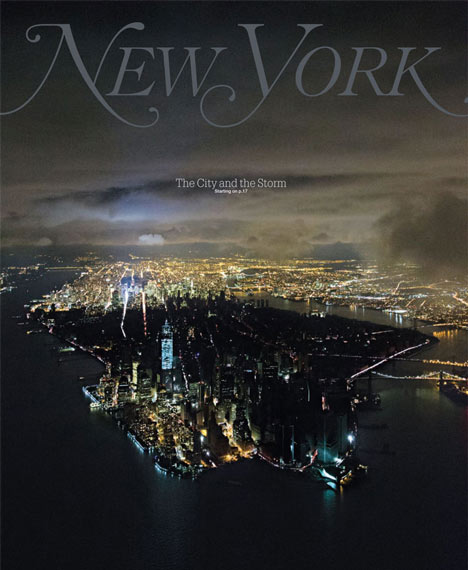New York after the storm by Iwan Baan
Slideshow feature: this set of images by Dutch architectural photographer Iwan Baan shows the scene in New York over the past week as the city recovers from the effects of Hurricane Sandy that swept across Manhattan last Monday, cutting the electricity and flooding the streets and subways.

Iwan Baan also photographed the city from the air, creating a striking photograph that made the cover of New York Magazine (above). The image shows part of the city in darkness, while the rest is is filled with light and colour. "It was the only way to show that New York was two cities, almost," Baan told Poynter magazine. "One was almost like a third world country where everything was becoming scarce. Everything was complicated. And then another was a completely vibrant, alive New York."
A week later the city is now getting back to normal, with power mostly restored, schools reopening and subways running again.
Earlier this year Iwan Baan photographed a vertical slum in Venezuela for an exhibition that won the Golden Lion for best project at the Venice Architecture Biennale. Watch the interview we filmed with Baan about the project.
See more photography by Iwan Baan »
Here's a short statement from Baan on his experience photographing the city from above:
"I’ve photographed Manhattan from above many times in the past, so when I set out to shoot, I had already in mind my approach. I also thought, the only way to truly show how the island, which was now divided by those with power, and those without, was to find a helicopter, and shoot it from the sky.
I began calling on all of the heli-pilots I could think of in the Manhattan area, but each of them were either without fuel, on recovery efforts, or without power themselves. To my relief, after nearly exhausting all efforts, I managed to get a hold of a pilot who I had met just a week prior, and he said yes, he was able to fly.
The day after Sandy struck, I had reserved a car in Manhattan - just in case. But to my demise, the rental company had already given away my reservation, leaving me without a car, and without a means to getting to the helipad.
After a bit of negotiating, I finally found a rental at JFK. And 4 hours of standstill traffic, closed bridges and a $2000.00usd price tag later, I made it to the airport and had the car keys in hand.
Before I could shake off a bit of the frenzy that was going around, my phone rang. It was New York Magazine calling, and all that I could make out through the broken network reception was the word helicopter. With the phone lines being as bad as they were, it was completely impossible to hear what they were saying, but I figured I’d make my way to the heliport no matter what. I had already made my 4-hour trek out of Manhattan, so I could make it there in a breeze.
Renting a car, hunting for gas and inching my way through traffic to get to the heliport was by far the most trying and difficult part of getting this shot!
Without doors on the heli, it was a freezing cold, hour-long ride to fly into Manhattan. I spent about an hour above the city, where I knew I wanted to capture these two cities – one, a vibrant and pulsating Manhattan that we recognise so vividly, and its antonym – a lifeless city turned pitch black and ominous.
Illuminating the bottom left of the photograph is the glowing Goldman Sachs building. Just next is the construction site for the World Trade Centre, which is top-to-bottom, lit with power (despite the rest of lower Manhattan being completely powerless). I think perhaps, this ‘division of power’ is an allegory for the county’s declining infrastructure, telling us also about who is truly prepared for when sobering events like Sandy strike."